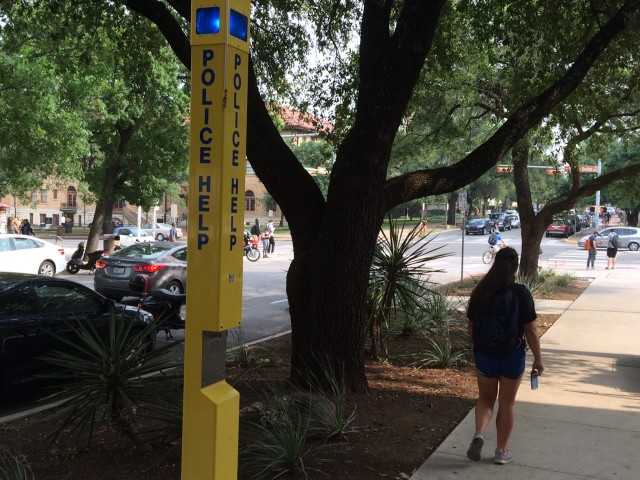UT Campus Call Boxes Are Rarely Used to Report Dangerous Situations
By Miranda Mason
Reporting Texas

Police question the usefulness of 172 callboxes scattered through the University of Texas at Austin campus. Reporting Texas
For Reporting Texas
The recent slaying of a student at the University of Texas at Austin has drawn increased scrutiny on the measures it uses to assure the campus is safe, which include police emergency call boxes situated throughout campus.
Freshman Haruka Weiser texted her roommate around 9:30 p.m. on Sunday, April 5, to say she was on her way to her dorm. Two days later, her body was discovered behind the Alumni Center near Waller Creek.
The university has a 130-member campus police force with the same powers as the Austin Police Department. The school also has 172 yellow call boxes scattered throughout the grounds so people can call for help in an emergency. But there’s little evidence that the call boxes are effective, according to interviews with police and a campus safety expert. In most cases, police responding to the calls find no one there, according to Officer William Pieper, part of the three-person campus police crime prevention.
“Most of the call box activations were of an unknown nature, meaning there was no answer on the other end of the telephone line and nobody in the area when the officer arrived,” he told Reporting Texas. He said the boxes were activated 156 times in 2013, 204 in 2014 and 114 times in 2015.
Pushing a button on the boxes, marked “POLICE HELP” and illuminated with blue lights, connects callers to campus police dispatch. In some cases, the calls are for non-emergency situations such as flat tires or pranks, like the time a person tried to order drinks.
Every week, officers check the call boxes in their assigned districts. The test includes looking at the blue light and activating the box to confirm it connects to the dispatcher. Figures on the cost of maintaining the call boxes were not immediately available, according to a university public information officer. A map of their locations is not published on the UT website.
Universities tend to be behind the curve in terms of security best practices, said Michael Dorn, executive director of Safe Havens International, a campus safety nonprofit based in New York City.
“I don’t know of any reliable data to show that [call boxes] deter crime, but affording staff and students an opportunity to summon help rapidly is helpful,” Dorn said. “Emergency duress apps for portable phones are becoming much more popular.”
UT does not have a campus-specific cellphone app, although anyone can call 911 in an emergency.
Dorn added that any tool to help someone communicate in an emergency is helpful. Other leading campus safety practices include threat evaluations based on surveys of students and staff, security cameras with capabilities to record specific patterns of behavior and delivering information using mass notification systems.
Caroline Starling, a 21-year-old biology junior who heads the Campus Safety Agency, part of student government, said the university needs to do better to educate students about campus safety measures, which include a program allowing people to call for an escort if they’re walking on campus at night. The number to arrange a walk is 512-232-9255.
“We need to promote services more often so that students are aware of the resources available. Additionally, certain projects such as increasing lighting or surveillance in various areas of campus could be beneficial,” Starling said.
Only five to 10 students attend the optional sessions on campus safety during freshman orientation, Pieper said. The sessions for parents draw more than 100, he added.
Pieper said that just because nothing comes of the calls most of the time, the call boxes should not be discredited as a tool to help keep the campus safe. Not everyone has a cellphone at the ready to call for help if they feel they are in danger.
“We have had activations in my 22-year-career that led to police activity, arrests in domestic violence cases, even one case that the suspect wanted to turn themselves in,” he said.
Campus police have doubled their patrols from 9 p.m. to 2 a.m. since the Weiser killing, Pieper said. “In addition, we are currently running 10-hour shifts with overlapping schedules.”
Meechaiel Criner, a homeless 17-year-old, has been charged with first-degree murder in the Weiser killing. A surveillance camera shows him following Weiser across a bridge near the Alumni Center around 9:40 that Sunday night, according to Austin police. He later was found with items that may have belonged to her. He is in custody on a $1 million bond. Police have said they do not know a motive.
On April 20, UT President Greg Fenves said he had asked the Texas Department of Public Safety to review campus security and recommend improvements by the end of August. Fenves said the review will be comprehensive, covering both the main campus and the Pickle Research Campus in North Austin, the role of security personnel, video monitoring systems and design aspects such as lighting. He said he will implement the changes that DPS recommends.